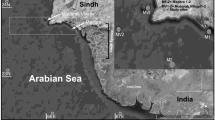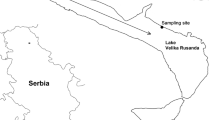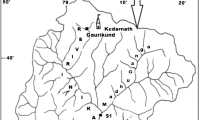Abstract
Pulicat lagoon in the south-east coast of India is recharged with the highest fresh water influx annually during north-east winter monsoon. An abrupt heavy rainfall in November–December 2015 was a flood calamity in the region that inundated the lagoon. We investigated the physico-chemical characteristics and palynological profile of the surface sediments from the lagoon at water depth between 0.5 and 2 m to understand the impact of the 2015 event. On the basis of a ‘marine index’, three zones were demarcated, the ‘LC zone’ (Araniar river-lagoon confluence, south), the ‘LM zone’ and the ‘LL zone’ (Kalangi river confluence, north) showing values of 4.55, 1.25 and 0.25, respectively, indicating the extent of tidal influence. The dissolved oxygen, pH and salinity ranged between 6.4 and 9.6 mg/L, 7.96–9.23 and average ~ 12.3 ppt at different sites, respectively. The highest salinity (31 and 31.8 ppt) was in the LC zone along with the highest dissolved inorganic nitrogen (DIN) concentrations (275–288 mmol/m3) too. The dissolved inorganic phosphates (DIP) ranged between 8.5 and 29.5 mmol/m3, which was relatively high. Sandy sediment, high sodium (Na+) and chloride (Cl−) ions too indicate the landward extension of seawater influx. Forsterite (Mg2SiO4) and beta-uranophane (Ca[(UO2)SiO3(OH)]2.(H2O) minerals show higher values with the dominance of olivine (MgFe)2SiO4) and quartz (SiO2) in this zone indicating magnitude of fresh water influx too through Araniar river. The highest calcium, magnesium and potassium ions were also observed in LC zone. Fe-rich goethite, calcite and aragonite were recorded at all sites but with dominance of illite in LL zone. Halite, an evaporite recorded from all sites shows inundation of the entire lagoon during flooding event. Results show a bloom of Biddulphia pulchella, B. biddulphiana and B. laevis in association with Cladophora in LC zone which serves as potential indicators of physico-chemical characteristics of the lagoon showing intense response to catastrophic events of floods due to above normal monsoon variability.







Similar content being viewed by others
References
Aziz, A. (2005). Brackish water algae from Bangladesh. I. Biddulphia spp. Bangladesh Journal of Botany, 34(2), 109–113.
Biscaye, P. E. (1965). Mineralogy and sedimentation of recent Deep-Sea clay in the Atlantic Ocean and adjacent seas and oceans. Geological Society of America Bulletin, 76(7), 803–832. https://doi.org/10.1130/0016-7606(1965)76[803:masord]2.0.co;2.
Boedeker, C., & Immers, A. (2009). No more lake balls (Aegagropila linnaei Kützing, Cladophorophyceae, Chlorophyta) in the Netherlands? Aquatic Ecology, 43(4), 891–902. https://doi.org/10.1007/s10452-009-9231-1.
Boyer, A. M. (1900). The Biddulphoid froms of North American Diatomaceae. In Proceedings of the academy of Natural Sciences of Philadelphia (pp. 685–730).
Chao, W. C., & Chen, B. (2004). Single and double ITCZ in an aqua-planet model with constant sea surface temperature and solar angle. Climate Dynamics, 22, 447–459.
Crayton, W., & Sommerfeld, M. (1979). Composition and abundance of phytoplankton in tributaries of the lower Colorado river, grand canyon region. Hydrobiologia http://link.springer.com/article/10.1007/BF00019143. Accessed 4 May 2016, 66, 81–93.
Erdtman, G. (1952). Pollen morphology and plant taxonomy—angiosperms. Stockholm: Almqvist and Wiksell 539 p.
Farooqui, A., Ranjana, & Nautiyal, C. M. (2016). Deltaic land subsidence and sea level fluctuations along the east coast of India since 8 ka: a palynological study. The Holocene, 26(9), 1426–1437.
Galland, G., & Pennebaker, S. (2012). A benthic diatom bloom in the Gulf of California, Mexico. BioInvasions Records, 1(1), 65–69 http://www.reabic.net/journals/bir/2012/1/bir_2012_1_galland_pennebaker.pdf. Accessed 30 Aug 2017.
Ganguly, D., Robin, R. S., Vardhan, K. V., Muduli, P. R., Abhilash, K. R., Patra, S., & Subramanian, B. R. (2013). Variable response of two tropical phytoplankton species at different salinity and nutrient condition. Journal of Experimental Marine Biology and Ecology, 440, 244–249.
Ganguly, D., Patra, S., Muduli, P. R., Vardhan, K. V., Abhilash, K. R., Robin, R. S., & Subramanian, B. R. (2015). Influence of nutrient input on the trophic state of a tropical brackish water lagoon. Journal of Earth System Science, 124(5), 1005–1017. https://doi.org/10.1007/s12040-015-0582-9.
Gordon, N. D., McMahon, T. A., Finlayson, B. L., & Gippel, C. J. (2004). Stream hydrology: An introduction for ecologists. John Wiley and Sons.
Govindasamy, C., & Anantharaj, K. (2012). Scanning electron microscopic ( SEM ) studies on epiphytic diatom of Biddulphia pulchella on seagrass in Palk Strait-new record. Advances in Biological Research, 6(2), 78–80. https://doi.org/10.5829/idosi.abr.2012.6.2.63115.
Grasshoff, K., Kremling, K., & Ehrhardt, M. (Eds.) (1999). Methods of seawater analysis (Third edition). Wiley VCH. Accessed 4 May 2016.
Grimm, E. (1987). CONISS; a Fortran 77 program for stratigraphically constrained cluster analysis by the method of incremental sum of squares. Computers and Geociences, 13(1), 13–35 http://www.sciencedirect.com/science/article/pii/0098300487900227. Accessed 30 Aug 2017.
Guiry, M. D., & Guiry, G. M. (2017). Cladophora glomerata. AlgaeBase. World-wide electronic publication, National University of Ireland, Galway. http://www.algaebase.org/search/genus/detail/?genus_id=37. Accessed 1 Nov 2017.
Ingram, R. L. (1971). Sieve Analysis 1. In Procedures in sedimentary petrology (pp. 49–67). Wiley Interscience, New York.
Institute of Ocean Management (IOM), Anna University Chennai (2003). No Impact Zone studies in critical habitats : Pulicat lake ecosystem, Integrated Coastal and Marine Area Management (ICMAM) Project Directorate, Government of India; Online report. Accessed from: http://www.icmam.gov.in/pub.htm.
Jayakumar, R., Steger, K., Chandra, T. S., & Seshadri, S. (2013). An assessment of temporal variations in physicochemical and microbiological properties of barmouths and lagoons in Chennai (southeast coast of India). Marine Pollution Bulletin, 70(1–2), 44–53. https://doi.org/10.1016/j.marpolbul.2013.02.005.
Kaliyamurthy, M. (1975). Observations on the plankton ecology of Pulicat lake. Indian Journal of Fisheries, 22(142), 86–95.
Kaur, S., & Purohit, M. K. (2016). Rainfall Statistics of India - 2015, ESSO/IMD/H, 97. http://hydro.imd.gov.in/hydrometweb/(S(d1ymj1451ysgvn55yh3d1jim))/PRODUCTS/Publications/RainfallStatisticsofIndia-2015/RainfallStatisticsofIndia-2015.pdf.
Kociolek, J. P., Lamb, M. A., & Lowe, R. L. (1983). Notes on the growth and ultrastructure of Biddulphia Laevis Ehr. (Bacillariophyceae) in the Maumee River, Ohio. The Ohio Journal of Science, 83(3), 125–130 http://hdl.handle.net/1811/22933.
Kumar, P., Kumar, K. R., Rajeevan, M., & Sahai, A. K. (2007). On the recent strengthening of the relationship between ENSO and northeast monsoon rainfall over South Asia. Climate Dynamics, 28(6), 649–660. https://doi.org/10.1007/s00382-006-0210-0.
Kurian, V. (2016). Eventful north-east monsoon of 2015 has passed, says Met. Newspaper report, Business Line, Thiruvananthapuram, India January 7.
Lebour, M. V. (1930). The planktonic diatoms of northern seas (pp. 1–244). London: Royal Society Publication.
Lucchitta, I., & Suneson, N. (1981). Flash flood in Arizona- observations and their application to the identification of flash-flood deposits in the geologic record. Geology, 9(9), 414–418. https://doi.org/10.1130/0091-7613(1981)9<414:FFIAOA>2.0.CO;2.
Madhav, V. G., & Kondalarao, B. (2004). Distribution of phytoplankton in the coastal waters of east coast of India. Indian Journal of Marine Sciences, 33(3), 262–268.
Mishra, A. K. (2016). Monitoring Tamil Nadu flood of 2015 using satellite remote sensing. Natural Hazards, 82(2), 1431–1434. https://doi.org/10.1007/s11069-016-2249-5.
NandaKumar, N. V., Nagarjuna, A., & Reddy, D. C. (2010). Ecoresiliency and remediation strategies for biodiversity conservation of aquatic and avifauna of Pulicat brackish water lagoon. World Journal of Fish and Marine Sciences, 2(5), 389–400.
Nriagu, J. (1978). Dissolved silica in pore waters of Lakes Ontario, Erie, superior sediments. Limnology and Oceanography, 23(1), 53–67. https://doi.org/10.4319/lo.1978.23.1.0053.
Purvaja, R., Ramesh, R., Shalini, A., & Rixen, T. (2008). Biogeochemistry of nitrogen in seagrass and oceanic. Memoir Geological Society of India, 73, 435–460 http://www.ncscm.res.in/cms/about-us/publications/2008-3.pdf. Accessed 30 Aug 2017.
Qasim, S. Z. (1977). Biological productivity of the Indian Ocean. Indian Journal of Marine Sciences, 6, 122–137 http://nopr.niscair.res.in/handle/123456789/39365. Accessed 30 Aug 2017.
Rajamanickam, R., & Nagan, S. (2016). A study on water quality status of Major Lakes in Tamil Nadu. International Journal of Research in Environmental Science, 2(2), 9–21.
Rajeevan, M., Unnikrishnan, C. K., Bhate, J., Niranjan Kumar, K., & Sreekala, P. P. (2012). Northeast monsoon over India: variability and prediction. Meteorological Applications, 19(2), 226–236. https://doi.org/10.1002/met.1322.
Raman, K., Kaliyamurthy, M., & Joseph, K. O. (1977). Observations on the ecology and fisheries of the Pulicat lake during drought and normal periods. Journal of Marine Biological Association of India, 19(1), 16–20 http://ciba.res.in/Books/ciba0299.pdf.
Ramanamurthy, M. V., Sriganesh, J., Pari, Y., & Varthini, D. (2014). Characteristics of tidal inlets in wave dominated coast. In Proc. Indo-Japan Workshop on River mouths, Tidal flats and Lagoons (pp. 1–12). https://www.researchgate.net/profile/Sriganesh_Jeyagopal/publication/279767131_CHARACTERISTICS_OF_TIDAL_INLETS_IN_WAVE_DOMINATED_COAST/links/559a7a7308ae21086d26b7eb.pdf. Accessed 30 Aug 2017.
Ramesh, R., Purvaja, R., Ramesh, S., & James, R. A. (2002). Historical pollution trends in costal environments of India. Environmental Monitoring and Assessment, 79, 151–176. https://doi.org/10.1023/A:1020250717093.
Redekar, P. D., & Wagh, A. B. (2000). Planktonic diatoms of the Zuari estuary , Goa ( west coast of India ). Seaweed Resources Utilisation., 22(1&2), 107–112 http://drs.nio.org/drs/handle/2264/375. Accessed 3 May 2016.
Sanjeevaraj, P. J. (2011). Management of the food web in Pulicat Lake. Indian Journal of Environmental Education, 11, 5–16 http://cpreec.org/Indian_Journal_VOL.11_April2011.pdf#page=4.
Santhanam, H., & Amalraj, S. (2016). Nutrient Budgets for Pulicat Lagoon using the LOICZ Approach. In ENVIS Special Publication, Lagoons of India, State-of-the-art Report, ENVIS Series 2/2015, Centre for Advanced Studies in Marine Biology, Parangipettai, Tamilnadu, sponsored by Ministry of Environment and Forests, Government of India (pp. 7–22).
Santhanam, H., & Natarajan, T. (2018). Short-term desalination of Pulicat lagoon (Southeast India) due to the 2015 extreme flood event: insights from Land-Ocean interactions in coastal zone (LOICZ) models. Ecological Processes, 7(1), 10.
Santhanam, H., Amalraj, S., & Thanasekaran, K. (2010). Selection of suitable ecosystem indicators as tools to assess the ecosystem health of coastal lagoons and their implications in management. Asian Journal of Water, Environment and Pollution, 7(2), 59–64.
Sreekala, P. P., Rao, S. V. B., & Rajeevan, M. (2012). Northeast monsoon rainfall variability over south peninsular India and its teleconnections. Theoretical and Applied Climatology, 108(1–2), 73–83. https://doi.org/10.1007/s00704-011-0513-x.
Srivastava, J., Farooqui, A., & Seth, P. (2018). Pollen-vegetation relationship in surface sediments, Coringa mangrove ecosystem, India: palaeoecological applications. Palynology, p 1–16.
Subrahmanyan, R. (1946). A systematic account of the marine plankton diatoms of the Madras coast. Proceedings of the Indian Academy of Sciences, 24(4), 85–197 link.springer.com/content/pdf/10.1007/BF03049673.pdf.
Tsutsui, I., Miyoshi, T., Sukchai, H., Pinphoo, P., Aue-umneoy, D., Meeanan, C., Songphatkaew, J., Klomkling, S., Yamaguchi, I., Ganmanee, M., Sudo, H., & Hamano, K. (2015). Ecological and morphological profile of floating spherical. Cladophora socialis aggregations in Central Thailand. PLoS One, 10(4), 1–17. https://doi.org/10.1371/journal.pone.0124997.
Van Oldenborgh, G. J., Otto, F. E. L., Haustein, K., & Achutarao, K. (2016). The heavy precipitation event of December 2015 in Chennai, India. Bulletin of the American Meteorological Society, 97(12), S87–S91. https://doi.org/10.1175/BAMS-D-16-0129.1.
Wang, Z., Qi, Y., Chen, J., Xu, N., & Yang, Y. (2006). Phytoplankton abundance , community structure and nutrients in cultural areas of Daya Bay , South China Sea. Journal of Marine Systems, 62, 85–94. https://doi.org/10.1016/j.jmarsys.2006.04.008.
Zubair, L., & Ropelewski, C. F. (2006). The strengthening relationship between ENSO and northeast monsoon rainfall over Sri Lanka and southern India. Journal of Climate, 19(8), 1567–1575. https://doi.org/10.1175/JCLI3670.1.
Acknowledgments
The authors thank the Director, BSIP, Lucknow, India, for providing the facilities for the sedimentary analyses and microscopicanalyses. Harini Santhanam (HS) wishes to acknowledge the funding support for the field work at Pulicat from Department of Science and Technology (DST), India, under Woman Scientists Scheme. HS is also grateful to Prof. Sudhakar Rao, Chairman, Civil Engineering, IISc Bangalore, India, for the analytical support to carry out the analyses of environmental parameters. The assistance provided by Mr. Ananth Nag, IISc for ICP-OES is gratefully acknowledged. HS thanks Mr. Sudharshan Bhat and Prof. T.V. Ramachandra at IISc for support with the CHN analyses of the sediments. The authors gratefully acknowledge the support of Dr. Thulasiraman Natarajan, IISc and Mr. Suresh Kumar, JNCASR, Bangalore, during various stages of the work. The authors thank three anonymous reviewers of a previous version of the manuscript for their comments that have helped to improve it.
Author information
Authors and Affiliations
Corresponding author
Rights and permissions
About this article
Cite this article
Santhanam, H., Farooqui, A. & Karthikeyan, A. Bloom of the diatom, Biddulphia sp. and ecology of Pulicat lagoon, Southeast India in the aftermath of the 2015 north east monsoonal rainfall. Environ Monit Assess 190, 636 (2018). https://doi.org/10.1007/s10661-018-7020-9
Received:
Accepted:
Published:
DOI: https://doi.org/10.1007/s10661-018-7020-9




